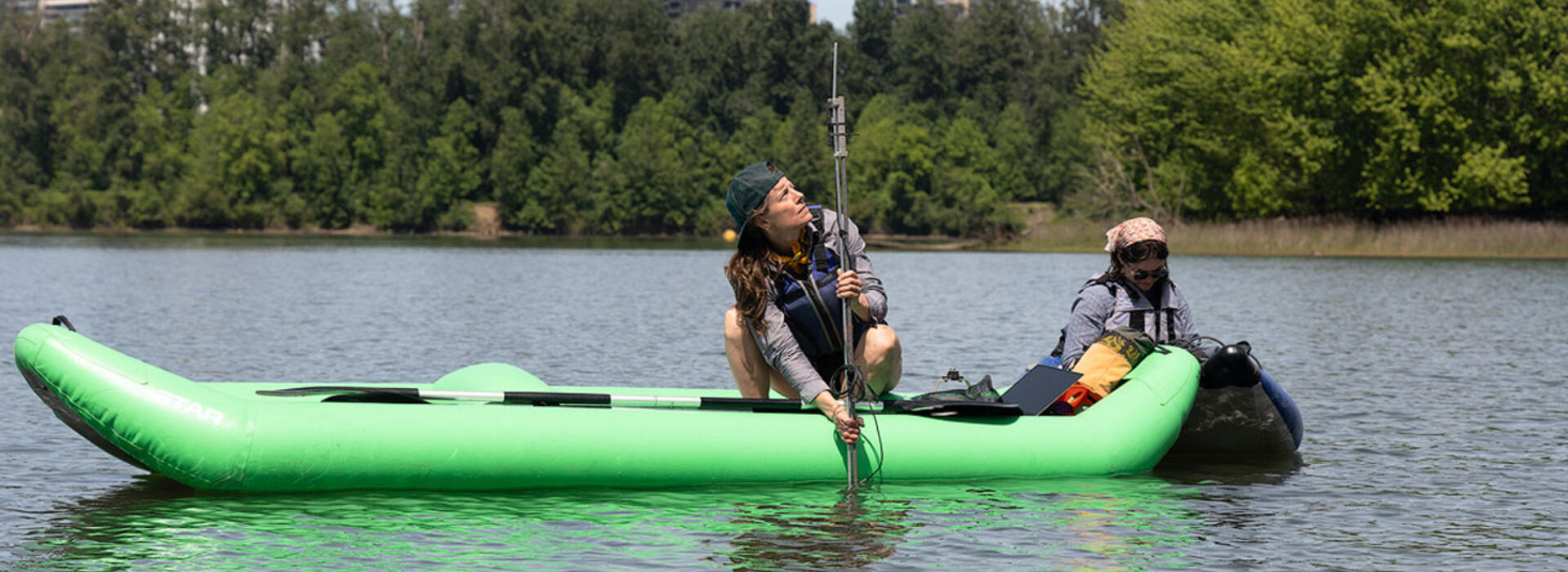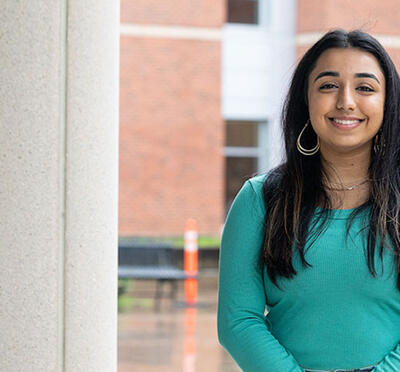Most summers, the Ross Island Lagoon, on the lower Willamette River in Portland, turns noticeably green from high concentrations of blue-green algae, or cyanobacteria.
In severe years, which occur with increasing frequency, these algal blooms spill out and paint the entire lower river green. The phenomenon, observed in the lagoon since 2009, poses a threat to both human health and the environment.
Desirée Tullos, a professor of biological and ecological engineering at Oregon State University, supports a team of scientists, managers, and river advocates in identifying viable solutions for mitigating the blooms.
The perfect breeding ground for cyanobacteria
Over the past decade, Tullos has been researching the hydrodynamics and water quality of the blooms. Modifications to the river over the past century have created a deep pool surrounded by islands, with limited connection to the mainstem river. Two big contributors to bloom intensity are stagnant water and warming water temperatures, making the lagoon, located upriver from the Ross Island Bridge, a perfect breeding ground for cyanobacteria.
Cyanobacteria blooms create toxins that can lead to illness in humans and animals. Dogs dying from drinking tainted water is the most common threat. In humans, prolonged exposure can cause abdominal pain, neurological symptoms, and liver damage, particularly in vulnerable populations. The blooms also impact the ecosystem, driving water pH up and depleting oxygen, which can kill off fish and other aquatic organisms.

“[Cyanobacteria] belong here and play a critical role in ecosystems,” Tullos said. “But humans have created conditions where they outcompete other organisms and grow to the point that they produce a lot of toxins and damage water quality.”
As winds and tides change, the blooms flow out from Ross Island Lagoon into the main channel and can travel miles downstream.
The accumulation of cyanobacteria in the lagoon is a byproduct of its history. In 1926, the Army Corps of Engineers built a levee connecting Ross Island with Hardtack Island to facilitate dredging the river bottom. Then, a gravel company mined the area from 1926 to 2001, increasing the lagoon’s depth to 120 feet.
The toll on human health and the environment
Over time, the ecosystem’s health has declined, affecting many species of fish, birds, and other wildlife. In 2018, the Environmental Protection Agency listed the Ross Island Lagoon as an “impaired waterway” due to the presence of harmful cyanobacteria.
The Willamette River is one of the largest natural recreation areas in Portland, providing opportunities for residents to cool off in the summer and interact with nature. The islands around the lagoon are home to herons and eagles, and juvenile salmon are believed to migrate through the shallow water in and around the lagoon. Cyanobacteria blooms, worsening with climate change, threaten the public’s relationship to this cherished waterway.
Degrading water quality impacts activities like kayaking, fishing, and swimming in the area. Growing public concern makes communicating the science underlying the blooms and their mitigation important, Tullos said.
Communicating to the public
A collaboration between Tullos and David Baker, an instructor of film, through Oregon State University Media Productions, resulted in the short film, “Restoring Ross Island: Solving Cyanobacteria Outbreaks on the Lower Willamette.” The film was screened at the Portland EcoFilm Festival in July.
“From an outreach and engagement perspective, I think the film has been really effective,” Tullos said.
Tullos has been explaining the science of cyanobacteria blooms in the Ross Island Lagoon and how they can be minimized through interviews with Oregon Public Radio and The Oregonian, with the intention of building public trust.
Partnering with the community
Tullos’ work has centered on a partnership with Willie Levinson, executive director of Human Access Project, a grassroots advocacy group connecting people to the Willamette River. The two met at one of the group’s organized swims in 2015.
“Water brings out the best in people,” Levinson says in the film. “Having relief from the built environment and being able to tap into our second largest public space and natural area is huge.”
Tullos agrees. “A critical role Oregon State University plays is being an extension of what we can learn as scientists and how that applies to people’s lives,” she said.
Oregon State has been collaborating closely on the Ross Island project with the United States Geological Survey and the Oregon Department of Environmental Quality. There are also more than 30 partner organizations, agencies, businesses, and individuals involved.
“It feels good that people are engaging. It’s been a community-based project built from the ground up,” she said.
The plan to restore Ross Island Lagoon’s ecosystem
Starting with acquiring baseline data in 2017, Tullos, a licensed professional engineer, is now working with her students and design engineers to develop advanced designs for the remediation of the Ross Island Lagoon. The plan is to reconnect the lagoon to the river by excavating a flushing channel through the artificial embankment that the U.S. Army Corps of Engineers installed nearly a century ago.
Digging out a new channel won’t restore the river to its natural state, but it will reduce the competitive advantage of the cyanobacteria, improving water quality and recreation. “It will reset some of the key hydraulic and ecological processes, turning this stagnant pond back into something more like a river,” Tullos said.
Improving ecosystem health in the lagoon could provide crucial habitats for beavers, river otters, federally protected Chinook and Coho salmon, and over 50 species of birds.
To establish a strong foundation, Tullos uses hydraulic data, measurements of the quality and movement of water, collected at the lagoon to simulate different design options via computer models. This cost-effective method eliminates the need for trial and error.
Zoe Chavis, a graduate student in Tullos’s lab, is conducting biological modeling, a complicated process that simulates how light, nutrients, and water temperature affect cyanobacteria growth. Her work aims to understand what factors control the blooms, and how well models can reproduce those factors. These models are then used to gauge how different designs affect water quality, but they are subject to a lot of uncertainties, Tullos said.
Funding the completion of the design plan
Before construction can begin, Tullos’s team needs confidence in some of the design’s details and effectiveness. This will require more funding, particularly from government agencies.
“We’ve been working with legislators, and my role is to provide information and answer questions that folks have,” Tullos said.
In July 2024, the project secured a $150,000 grant from Multnomah County, which has a strong interest in supporting a solution from both an environmental and a human health perspective.
This funding will move the project forward, allowing Tullos and her team to keep developing a comprehensive, basic design after determining the channel’s dimensions, known as a 30% design. However, the final shovels-in-the-ground moment is unknown.
“Blooms are hard to manage as they’re societal issues,” Tullos said. “With this one, it’s pretty clear what needs to happen, so it’s a matter of getting the motivation and the resources together.”
Members of the Human Access Project and researchers at Oregon State are determined to keep the momentum going by holding fundraisers and raising awareness among Portlanders. The reach of the initiative is even being taught in schools.
“There are kids in Portland who are aware of this and are invested,” Tullos said, citing a letter she received from a fourth grader. The note read, “If you restore the lagoon, the river will be balanced, and the lagoon will be clean. I really hope you can do it.”
Preserving waterways for the future
Tullos, who has an intimate connection to waterways, through spending much of her time swimming and rafting in rivers and surfing in the ocean, is motivated to keep these experiences available for other people.
“These rivers are living organisms in themselves, and they are our friends,” Tullos added. “I want a future where people have these relationships to each other and nature.”



